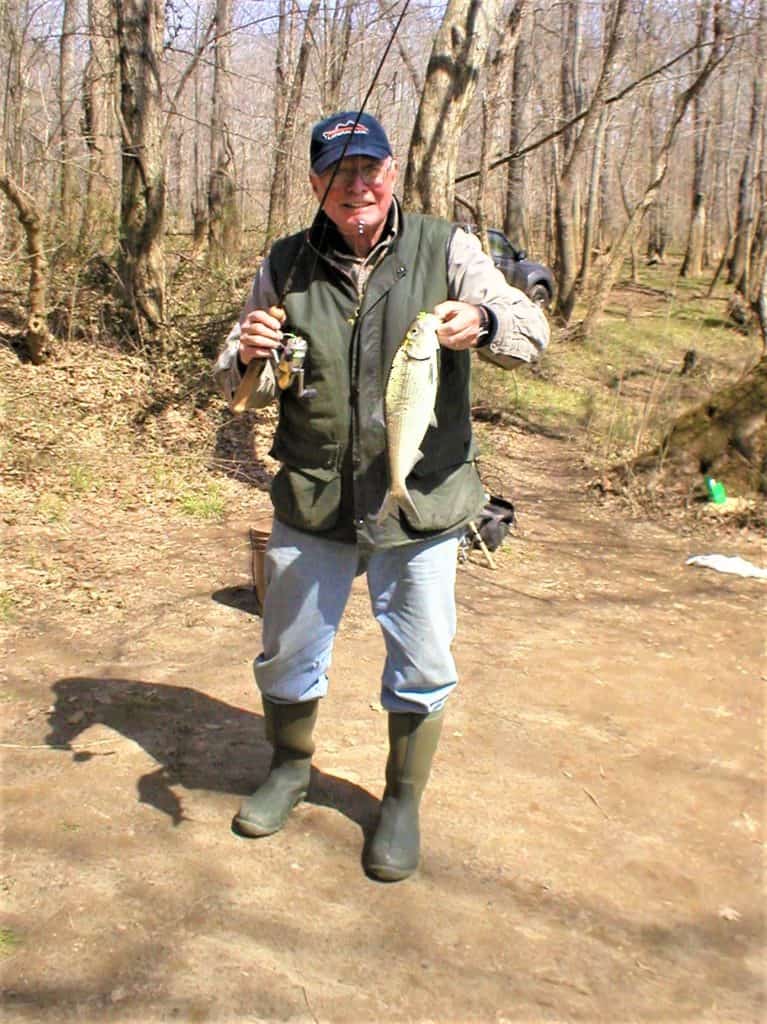Sporting Life

Your Choice: Leaping Silver Shad or Trophy Rockfish
By Dennis Doyle
Feeling a sharp bump, I set the hook with my 5-foot spin rod. At the end of my line a silvery torpedo launched out of the water, arced through the air a good 5 feet, splashed down gracefully and sped off downriver with my drag happily buzzing away. It was the fifth fish of the morning and there were more to come.
If you’re not quite ready to face the hordes of boats blanketing the Chesapeake for opening day of trophy rockfish season (May 1), there is a high-quality alternative. The hickory shad spawning run is at its peak right now and their numbers are encouraging.
Sometimes called silver shad, tailor, hick or jack shad, this member of the herring family was once a significant and popular food source during colonial times. Pickled, salted, smoked and dried, the hickories were regarded as a delicious and an important spring source of protein.
While not recovered enough in Maryland waters to allow harvest, there is a thriving catch and release season for these aerial loving combatants and they are exciting to engage. Living their lives running wild in the Atlantic, the hickory shad reaches lengths of up to 24 inches, every inch of them muscle and speed. They return every year to the Tidewater to reproduce about this time.
Principally harvested in the recent past for their delicious roe, the fish are currently struggling to rebuild populations depleted by spawning areas devastated by hurricanes, poor sediment control by developers and commercial overharvesting for bait, fertilizers and fish oil.
I have, however, seen ever-increasing numbers in local tributaries over the last few years and feel optimistic that they just once again may reach healthy populations.
Ultra-light and light spin tackle spooled with 4- to 6-pound mono is the proper media to experience these game fish. The traditional terminal tackle is a tandem set of shad darts in weights that will trail just above the bottom in the waters you are fishing. That means having a good selection of darts from 1/32 through ¼ ounce. Color choices of lures are myriad and important. Shad seem partial to particular colors, unfortunately these colors change almost daily, certainly weekly. Chartreuse is generally popular as is white, both with red or black trim. Other days blaze orange or yellow will be the ticket. The color of the calf tail wing varies as well with white, chartreuse or yellow being the norm.
Hickories don’t feed during their run but will strike other lures, including silver and gold spoons, spinners and soft plastic curly and paddle tail jigs, usually in chartreuse. Since white perch, yellow perch, crappie and pickerel are also present in various stages of their spawn, one never really knows what’s on the end of their line until it reveals itself. Anglers often hedge their bets with a baited lure being one half of the tandem setup and a spoon or dart being the other offering.
The Department of Natural Resources recommends the Upper Patuxent, the whole of the Choptank, the Gunpowder, the Little Northeast River, the Susquehanna River and Deer Creek as more the reliable tributaries frequented by the spring runs of hickories. Maps and directions are available on the DNR website.
American or white shad also run at this time of year. Far fewer though easily twice the size of hickories, these fish frequent the same waters and will give a similar but more powerful style battle, generally broaching the tributary waters when fighting rather than jumping clear. Both fish provide a most memorable sporting experience.
******
Fishfinder:
Since the Bay proper has been totally closed to any kind of angling for rockfish during April the information on concentrations of striped bass is nil. One can count on the fact that the bigger fish have mostly finished their spawning runs and are on their way back to the Atlantic. Falling tides will find them south of river mouths and riding the currents back to saltier waters. The general consensus is that the stronger outgoing tides are located on the western side of the Bay so that’s a good place to start. Another factor complicating the search is that the migrating fish will be feeding up, recovering from the spawn and will hold on any large concentrations of bait, at least until their appetites are sated. The baitfish could be massing on either side of the Bay. Hickory shad are at the high point of their spawning runs throughout the Bay, white perch are winding down and yellow perch are mostly done but late comers will be found just about anywhere. The trophy rockfish season starts May 1 with minimum size at 35 inches and a one fish limit. The season has erupted and it’s going to be wonderful fishing from now on. Enjoy the Chesapeake and all of its tributaries and wild resources.
